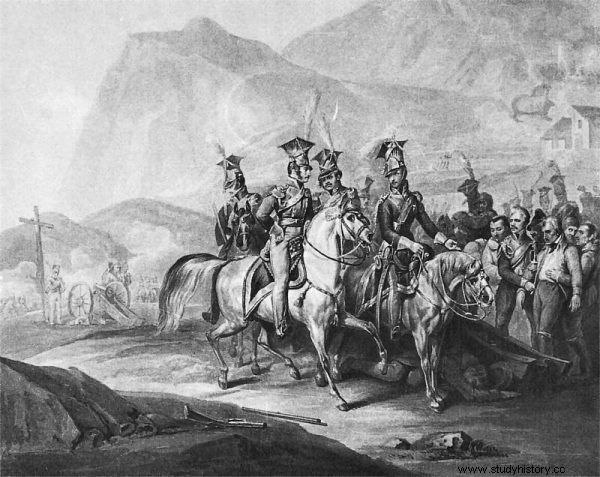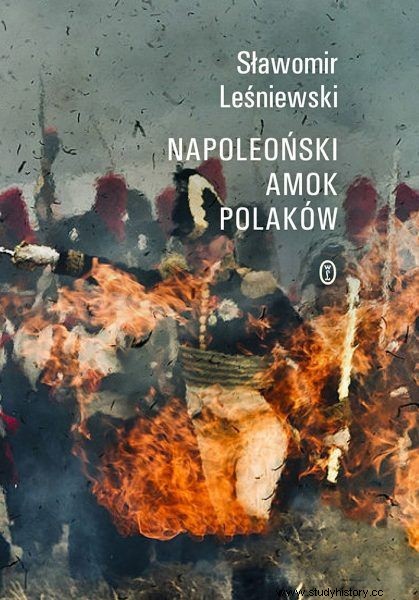Penal expeditions against rebellious populations. Murdering women and children. Raze the whole town to the ground. This is not a description of the crimes committed by the Germans or the Russians. This is the "output" of Polish legionnaires pacifying the inhabitants of the Apennine Peninsula who fought for freedom.
Dąbrowski's Legions, standing at the side of Napoleon in Italy, if we associate them with something, probably with courage and tenacity in battle. However, Sławomir Leśniewski in his new book entitled "Napoleonic amok of Poles" it also draws attention to the less glorious episodes in their story.
Murderers of women and children
Our countrymen were used by the French to bloody suppression of the rebellious population areas just conquered by the Corsican. This happened, for example, in the Circeo department near Rome. As we read in "Napoleonic amok of Poles" :
The rush that started on July 24 [1798] was not taken seriously at first. However, within a few days it covered a large area, and the insurgents from the very beginning fought with ferocity and cruelty, often murdering representatives of the authorities favoring the occupant in a sophisticated manner.
At the end of the month, Poles [...] stormed Ferentino, which earned them both the admiration of the French and the hatred of the insurgents. They accused the legionnaires of murdering women and children and of ruthlessly plundering the town.
A few days later, the French could not praise the courage of the legionnaires who took part in the capture of Frosinone. General Etienne Macdonald even claimed that:"Poles are as brave as possible." The unfortunate citizens of the city were of a different opinion. Many of them burned alive in buildings set on fire by soldiers .

The legionaries showed cruelty in the Circeo department, among others.
The cruelty of the attackers shocked even the refugees from near Ferentino. They claimed that "the scenes they saw there were nothing compared to the horrors that took place at Frosinone." Besides, the legionnaires themselves did not hide that they had no mercy for the opponents fighting until the end.
One of the Poles stated that " the soldier's bayonet quickly cleared the ground of them ". The uprising collapsed a few weeks after the bloodbath prepared for the rebels in Frosinone. As Sławomir Leśniewski writes, "one thousand three hundred Poles participated in the liquidation of the last insurgent centers of resistance and in capturing its leaders".
Ruthless extermination of the insurgents
However, it was not the end of using our countrymen to pacify the rebellious population. This role was also played by the legionnaires in the conquered Kingdom of Naples in 1799. The local population had no intention of meekly putting up with the French presence and started a bloody fight with the invader.
The Poles themselves learned about it painfully. Several of them died cruel deaths after falling into the hands of insurgents. In retaliation, the legionaries, led by the later dictator of the November Uprising, Józef Chłopicki, committed a real slaughter on Easter Sunday. In the book "Napoleonic amok of Poles" we read that:
Her cruelty was in no way inferior to that of the insurgents. During the night attack, the soldiers of the 2nd battalion of the 1st Legion together with French riflemen and fifty lancers captured Traetta, killed the defending insurgents, and the town's population was "cut down without feeding anyone" .

The curiosity is based on the book by Sławomir Leśniewski "Napoleoński amok Poles" (Wydawnictwo Literackie 2019).
But that was not the end at all. The Poles were not content with the murder and razed the town to the ground with the help of fire and gunpowder. On the ruins they left a boulder with the inscription:"Traetta was here - she rebelled - she is gone". Sławomir Leśniewski aptly notices that:
The barbarity that the Italian town first looked at and then experienced makes comparisons with the times of the Mongol invasions, the cruel crackdown of revolutionary France with the rebellious, faithful to the king and the Catholic religion Wandea or atrocities of the last world war.
Similar events resulted in increasing ferocity on both sides; to the bestiality of the insurgents the legionaries responded with punitive expeditions and their ruthless extermination . The war, terrible in its form, began to bring out demons that had been dormant so far.
The spiral of hatred in the following weeks only grew stronger, and the number of victims on both sides grew. Napoleon remembered well the effectiveness of the Poles in the fight against Italian rebels - a few years later he decided to use them to suppress the revolt on Santo Domingo. But that's a topic for a completely different article.
Source:
Trivia is the essence of our website. Short materials devoted to interesting anecdotes, surprising details from the past, strange news from the old press. Reading that will take you no more than 3 minutes, based on single sources. This particular material is based on the book:
- Sławomir Leśniewski, Napoleonic amok of Poles , Wydawnictwo Literackie 2019.
Find out what Poles loved Napoleon for:

